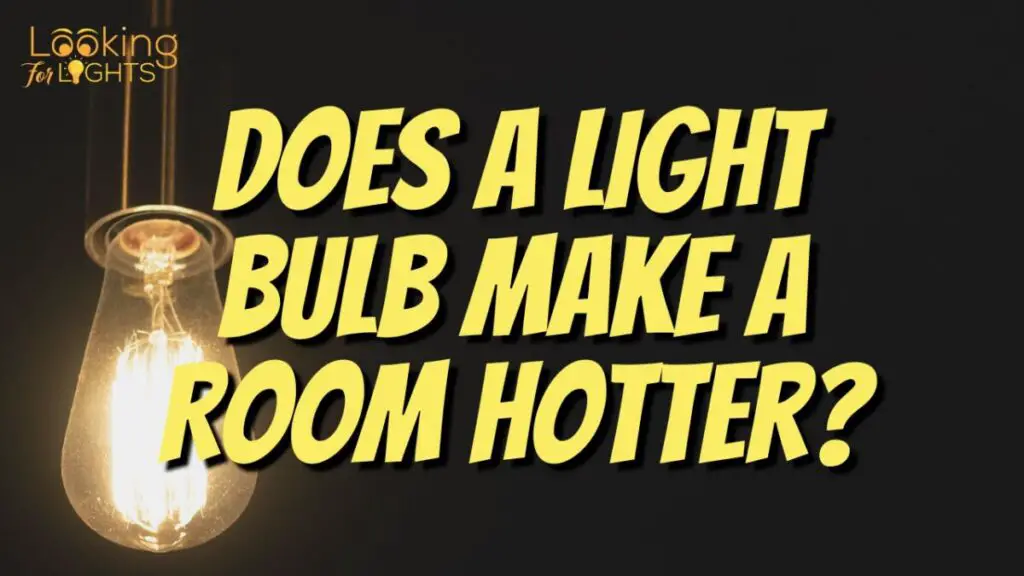You probably know that light bulbs are capable of generating heat in a room. But when it comes to the level of heat they generate, that information isn’t widely known.
So does a light bulb make a room hotter? Yes, they do. However, the level of warmth they give off solely depends on the size of the room and the number of light bulbs in it. This means that a small room is more likely to get hot quickly, especially if there are a lot of light bulbs inside it.
Further in this guide, you will understand the amount of heat light bulbs generate and the level of impact they have on the temperature of a room. Let’s dive right in!

Table of Contents
How Much Heat Do Light Bulbs Generate?
The law of conservation of energy states that energy cannot be created nor destroyed. Rather, it can only be converted from one form to another. Following this law, one thing is certain: a 60-watt lamp will produce 60 watts of electricity, which converts to 60 watts of heat and light energy.
Also, note that the amount of light generated has to do with the amount of electricity that is converted into heat. In some cases, some light bulbs give off more light and heat energy than their counterparts.
While incandescent light bulbs convert about 3-5% of energy, fluorescent light bulbs convert about 10-22% of electricity, and LED bulbs convert about 15% of energy. This tells you that bulb type and watt are part of the features that can greatly determine the amount of heat a light bulb emits.
In addition, the shape of the light bulb can affect the amount of heat it will give off. For example, if the bulb shape projects light in one direction, you will find out that more light and heat energy will be produced in that position. Likewise, a wider bulb shape will most likely have light spread across different areas of the home.
What Light Bulb Generates The Most Heat?
Start with, there are four major types of light bulbs, namely:
- The incandescent light bulb
- Halogen light bulb
- Compact fluorescent light bulb(CFL)
- Light-emitting diode (LED)
Each of the light bulbs generates heat and light energy differently irrespective of its color. Let’s look at how they individually function below:
CFLs come with a gas that creates light whenever electricity passes through them. About 30% of the energy used to produce light gives off heat, whether the glass is white or colored.
Both Halogen and Incandescent light bulbs generate their light through the electric current heating the metal filament inside the bulb. They use only 10% of their energy to produce light while the remaining 90% is used to produce heat.
Very often, incandescent light bulbs are utilized in different areas, such as:
- Incubators
- Heat lights (used in reptile tanks)
- Brooding boxes for poultry
- Lava lamps, and a host of other areas.
Incandescent light bulbs tend to exhibit the same characteristics regardless of the color of the light bulb.
LEDs emit their light every time electrons pass through a semiconductor material. They give off less heat and are so cool that you can touch them while they are on. LEDs come in various colors and produce the same amount of heat whether it’s a clear light bulb or a colored light bulb.
Does a Light Bulb Color Influence the Level of Heat They Generate?
When it comes to colors of light, some people generally perceive the combination of red, green, and blue lights to be white light. Others take yellow or red light bulbs as warm light. Then, blue lights are perceived as cool light, but the case is different with LEDs.
To be clear, all colored bulbs are generally white light bulbs. The only difference is that paints are usually added to the glass to display the exact color the user needs.
Which Is Better Between Warm Light Bulbs And Cool Light Bulbs?
There are no definite rules as to which one you should choose between the two as your personal preference will most likely influence your choice.
However, it will be worth noting that color temperature affects the aesthetics of your home and your body’s familiarity with sleep and alertness. This means that your decision can affect your health and general well-being.
To choose, you need to understand that warm lights have more red, yellow, and orange tones, which create softer lights. Cool lights have more blue, which gives off a much clearer and fresher light.
In addition, cool lights are also brighter than warm light bulbs, making them the most suitable option for task lighting. Contrastingly, warm light bulbs are common in residential apartments in the western world, Europe, and the United States. It sits at around 2700 to 3000 Kelvins and is mostly associated with a business. One of the features makes it suitable for home settings.
Note, cool light bulbs have a stark feature making them suitable for commercial building settings like hospitals, offices, and so on. Most cool lights sit around 3000-6000 Kelvin, a temperature that aids brain stimulation and alertness.
Color Temperature is expressed in Kelvins with the symbol, “K”. As the number increases, the brighter and colder the light bulb color becomes.
Can Fluorescent Lights Make A Room Hot?
Because they lack 100% energy, fluorescent lights can get hot. That way, they can effectively convert all electrical energy into light energy. But when compared to incandescent light bulbs, they generate little heat even when kept ON for a long period.
Moreover, they also contain mercury vapor that produces a short-wave ultraviolet light in the presence of an electric current. Asides from having more energy efficiency features, fluorescent light bulbs are also cooler than some other bulbs. As mentioned earlier, they only utilize 30% of their energy to produce heat.
Does Leaving The Light On Make The Room Hotter?
Yes, it does. However, it depends on the light bulb. An incandescent bulb will change the temperature of a room more quickly than a LED light, which is cooler and does not generate as much heat.
One thing you must know is that regardless of how hot a light bulb gets: it’s never enough to start a fire.
Tips For Choosing The Right Lighting Temperature For Different Areas of Your Home
Choosing the right lighting temperature or color temperature for a room can be a very challenging task. Nonetheless, it will be worth the stress if perfectly selected. That said, here are a few tips to consider while looking to choose the ideal light bulb temperature for your home:
Living Room
If you are to choose a color temperature for the living room, a very warm white light bulb with a lighting temperature of less than 3300° will be your best pick. That’s because this color will bring out beautiful decorative lighting that’s ideal for dinner, get-togethers, or a romantic hangout.
It also creates a cozy and relaxing atmosphere where you can watch movies, read magazines or entertain friends and acquaintances.
Different lighting temperatures can be chosen inside the living room depending on your lighting goals. You can choose pendants, wall sconces, table lamps, floor lamps, and ceiling lamps. For a bedroom, integrated LED lamps are a choice of light bulbs that offer extra advantages because of their lower energy consumption and their superior efficiency and durability.
Kitchen
Like the living room, the best lighting temperature or color temperature for a kitchen is a warm white color, which can stimulate the appetite for food. A LED spotlight is good as it can illuminate every space in the kitchen.
Bedroom
Any color temperature you choose for the bedroom must be able to provide coziness and a more welcoming environment. This is why you should choose warm lights that sit between 2700°K and 3000°K, color temperatures that fall in this range have the coziest tone.
Bathroom
Lastly, any lighting temperature is allowed for your bathroom. From cold to warm light, you still have to consider the style and size of the bathroom before making final buying decisions.
To be on the safe side, you can settle for cold light as it provides a sensation of sanitation and neatness. In addition, you can install different lighting temperatures in the bathroom depending on what you want.
In all, think about the position of the light bulb, then also, your style before choosing the right light bulb temperature for any part of your home.
Related post: 7 Reasons Incandescent Bulbs Are Dangerous
Conclusion
Overall, light bulbs can make a room hotter or even change the temperature of the room significantly, but that also depends on a ton of different factors.
From the light bulb type to the room size, to your lighting goals, and a whole lot of others. Once all these factors are considered, you are good to go.
We also saw that a regular incandescent light bulb will produce light simply by heating a tiny metal filament usually enclosed in a glass bulb. Let us hear your experiences regarding light bulbs heating your room. How did you handle it?

